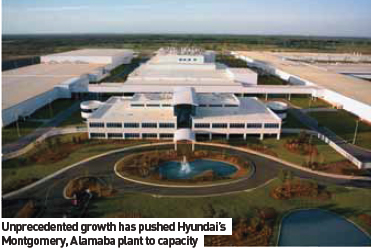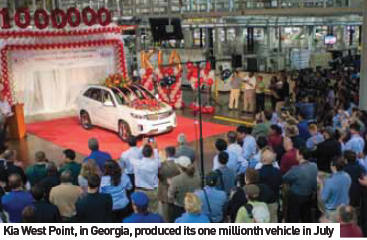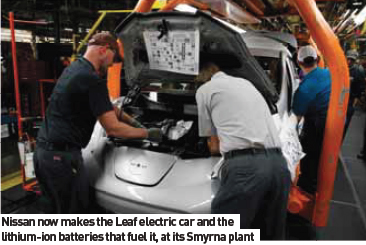Building on a reputation

Asian manufacturers are expanding their range and amount of production in North America, reveals Nick Gibbs
Japan’s major automakers, famously embedded into the North American manufacturing landscape, are set to become more so. Honda was first to establish itself in the US back back in 1982 when it began building the D-Segment Accord saloon in Marysville, Ohio; Toyota started in 1986 at Georgetown, Kentucky, with its C-Segment Corolla; and Nissan began producing a small pickup at its Smyrna, Tennessee, plant in 1983.
The hard graft needed to gain acceptance by the US car buyer has paid off and Toyota’s market share of 14% is now the biggest of any brand. Honda and Nissan are the fourth and fifth biggest behind Ford and Chevrolet.
The Asian manufacturers’ programme of localisation is in large part responsible for the fact that in the first six months of this year, 75% of cars sold in the US were made there.
Of all the Toyotas sold, 70% were made in the company’s 14 plants across North America; the figure is even higher for Honda, which claims 90% of its cars are built locally in one of seven facilities; and while Nissan lags behind, it has announced a goal to locally build 85% of the vehicles it sells in the US by 2015 when it will have six plants in the region.
Perhaps to convince a country of sceptical patriots, the local parts content is extremely high. Toyota’s D-Segment Avalon saloon regularly tops the ‘most American car’ charts based on content reported as part of the American Automobile Labeling Act (AALA) and the manufacturer claims that overall local content is 75%.
The firm’s desire to make where it sells even extends to within the States, as Chris Nielsen, president of Toyota Motor Manufacturing Texas, told a government subcommittee on commerce, manufacturing and trade in April this year. “We located in Texas because it is the biggest truck market in the US,” he said. The San Antonio plant began production of Toyota’s first full-scale pickup, the Tundra, in 2006, but only once the lack of suppliers in Texas was solved by its invitation to parts makers to set up shop on the plant site.
Honda’s US and Canadian content by value ranges between 65% and 75% depending on the vehicle, with only the entry Acura ILX executive saloon, made alongside the Civic at Honda’s Greensburg, Indiana, plant, dropping below 50%.
Nissan’s local content however, doesn’t climb above 50% for any model in the 2013 AALA list, hampered partly by the fact that the majority of its transmissions are sourced from Japan.
The factories where the Big Three Japanese makers first started out are now the biggest plants in the US bar none. Toyota’s Georgetown facility, its largest outside of Japan, is top in the 2013 half-year figures with 273,628 vehicles built, followed by Honda Maryville on 253,296 and Nissan Smyrna at 237,520. All grew volume compared to the previous year. At the end of 2013, Nissan will add the fastselling, Qashqai-based Rogue C-Segment crossover to its Smyrna roster from its current Japanese base, pushing the plant close to its 550,000-a-year capacity. Toyota is continuing to add volume as well, with ten production announcements in the past 20 months. The latest is a boost to production of its mid-size Highlander SUV at its Princetown, Indiana, plant by 2014 with investment of £30 million.
The confidence placed in their Northern American plants by the Japanese makers has been revealed by an unprecedented series of high-tech and premium investments for vehicles that once were the sole responsibility of the Japanese plants.
Nissan now makes both the Leaf electric car, starting early this year, and the lithium-ion batteries that fuel it, at its Smyrna plant. It also recently added an Infiniti model to the plant, bringing its premium brand into US production. Toyota, too, is increasing production of the Lexus luxury brand at its Cambridge, Ontario, plant, the only one outside of Japan to build a Lexus. It plans to add the RX450h large hybrid SUV in 2014 to the RX350 SUV it makes there, and will build the ES350 sedan in Georgetown from 2015.
Honda already builds the majority of its Acura luxury models in the US and Canada, but in May it made the surprise announcement that its flagship supercar, the Acura NSX, would be assembled in Marysville in a $70 million facility.
According to Ron Harbour, author of the Harbour Report on manufacturing productivity, the decision to increase premium production by the Japanese was made partly because it was getting too expensive back home while the yen was so strong, but also because North America offered the quality. “Those plants had proven they can could reach the same kind quality levels,” he says. “No one could tell the difference between a Lexus from Canada and one made in Japan.”
Perhaps the biggest vote of confidence was a recent announcement by Honda that its US operations would be taking the lead for developing manufacturing processes for new global models and instructing other plants around the world. “These are functions that, until now, were done in Japan and reflect the growing role of Honda’s US capabilities, resources, responsibility and know-how,” James Wehrman, head of manufacturing for Honda in North America, told the Subcommittee on Commerce, Manufacturing and Trade in April.
Outside of the Big Three Japanese manufacturers, Subaru announced in May it was expanding its Layfayette, Indiana, plant, which started in 1989, to add production of the C-Segment Impreza from 2016. The $400 million expansion will increase capacity by around 100,000 cars. In the year to the end of March 2013 it made 271,583 of the mid-size Legacy, the related Outback and the Tribeca large SUV. It also makes mid-size Camrys for Toyota.
Mitsubishi, meanwhile is having a tough time of it in the States and production at its Normal, Illinois plant has shrunk to just 37,019 in 2012 from a peak of 222,414 in 2000. However, in August the weakening yen was increasing profit on imported vehicles, while a switch in production to the Outlander Sport mid-size crossover is expect to boost output again.
In 2012, production in Mexico was still dominated by the 50% share of the Big Three US makers, almost double that of Asian makers, but the Japanese are currently leading new investment in the country and unlike in the US, that money is going into brand new plants.
Mazda hasn’t built in North America since a production agreement with former-shareholder Ford ended last year, but that will change in 2015 when the Japanese firm finishes construction of a brand new plant in Guanajuato state, Mexico, with a capacity of 230,000 vehicles.
 The $650 million Mazda facility will build the Mazda2 B-Segment, the Mazda3 C-Segment, as well as also 50,000 units of a new Toyota B-Segment based on the Mazda2. In August this year, Mazda also announced an engine plant on the same site with a similar capacity.
The $650 million Mazda facility will build the Mazda2 B-Segment, the Mazda3 C-Segment, as well as also 50,000 units of a new Toyota B-Segment based on the Mazda2. In August this year, Mazda also announced an engine plant on the same site with a similar capacity.
Not far from the new Mazda plant, Honda is also hard at work on a new facility at Celaya, Guanajuato, where it plans to build 200,000 of the Fit/Jazz subcompact a year. Earlier this year it also announced a transmission plant on the same site with an annual capacity of 350,000 from 2015, with plans to double that “in the coming years”.
A third big plant is being built by Nissan alongside its current Aguascalientes facility in central Mexico. The $2 billion investment in ‘Aguas 2’, two and half times larger than its neighbour, is set to begin production toward the end of this year with an initial output of 175,000 cars from Nissan’s B-Segment platform.
As Klier points out, all three are focusing on small cars because it’s in Mexico that the lower production-line wages, starting at around $40 a day, can offset the smaller margins on the increasingly popular fuel-efficient cars. It’s not just the Japanese who have realised that. Since 2010, Ford has built the B-segment Fiesta at its Cuautitlán plant near Mexico City and Chrysler builds the A-Segment Fiat 500 nearby at Toluca.
All manufacturers say that Mexican production boosts their sales within the country. With a whopping 25% share of the local market, Nissan makes the most convincing claim, but the reality is 83% of 2012 Mexican light vehicle production was exported, with 71% going to the US and Canada. The country is now reported to be the fourth vehicle largest exporter in world.
Just 16% of Mexican production goes into Latin America and 9% to Europe, but those figures are expected to improve thanks to Mexico’s 12 free-trade agreements – more than any other country in the world. “They’re what makes Mexico so competitive and because of these, manufacturers there have a tremendous interest in leveraging their facilities,” says Mike Jackson, director of North America vehicle production forecasting and analysis for IHS Automotive.
Showing what’s possible in terms of exports, VW’s vast Puebla plant near Mexico City, the biggest by production of any North American factory, exclusively makes Beetles and the C-Segment Golf estate for global markets, while Chrysler’s Toluca plant makes Fiat 500s for China as well as the US.
Following the US, Mexico is gearing up to become a production centre for premium cars too, confirming its maturity as a manufacturing base. “Over the past couple of decades it has had ample time to ramp up capabilities to bolster and expand its supply base, so as a result Mexico is reaching a new level of maturity,” says Jackson.
The US media has speculated that Nissan will add a small Infiniti model to its new Mexican plant. Meanwhile, as part of its partnership with Renault/Nissan, Daimler could potentially build the Mercedes CLA C-Segment sedan at the same plant, Daimler CEO Dieter Zetsche revealed in July this year. Nissan will build four-cylinder engines for both Mercedes and Infiniti from its Decherd, Tennessee, plant starting next year.
The other big premium investment comes from VW Group, which announced last year it would spend more than $900 million building a new factory for Audi in San Jose Chiapa, near VW’s Puebla plant. Production of a replacement for the current Q5 medium SUV will begin in 2016.
However, despite the investment, Mexico isn’t that much more cost effective than the US thanks mainly to logistics factors, according to Ron Harbour. “A significant buildup of suppliers down there has diminished the inbound trade penalty, but the biggest cost to offsetting labour is the outbound rate,” he says. “Then there’s security costs. This not a country without turmoil.” It’s no coincidence that BMW has based its security division, to retro-fit armour to cars like the 5-series saloon and X5 SUV, in Mexico.
The next automakers looking to build a new plant in North America could well be the related Korean firms Hyundai and Kia, both of whom have admitted they have reached capacity at their two US plants after a period of unprecedented growth in the country.
Sales for the pair topped half a million in the first half of the year, putting them on an equal footing with all European car makers combined and giving them a 13% share of the US market.
 Hyundai’s plant in Montgomery, Alabama, and Kia’s West Point, Georgia facility are working three shifts each with no more to give. Hyundai Motor America CEO John Krafcik told reporters earlier this year: “We have tapped everything at this point. There’s nothing left.”
Hyundai’s plant in Montgomery, Alabama, and Kia’s West Point, Georgia facility are working three shifts each with no more to give. Hyundai Motor America CEO John Krafcik told reporters earlier this year: “We have tapped everything at this point. There’s nothing left.”
The pace of growth has impressed Jackson at IHS. “Kia West Point, in very short order, went from being a brand new plant in 2009 to operating on three shifts. It’s is one the quickest ramp-ups we’ve seen.”
West Point was the tenth largest factory by production in the first half of the year with an output of 191,845 split between the Sorento medium SUV, its best-selling Optima D-Segment saloon and Hyundai’s Sante Fe medium SUV. In July this year it celebrated production of its one millionth vehicle.
Hyundai Montgomery produced even more to put it seventh, ahead of the biggest Ford factory with a figure of 210,413. It builds the Sonata D-Segment saloon and the Elantra C-Segment saloon.
Hyundai decided against building new plant in Quebec, Canada, in 2009 with Krafick saying he wanted to focus on quality rather than invest the money in new facilities: “There are no plans to expand capacity. We have shown the last few years that without a new plant we’ve been very capable of finding incremental production,” he stated.



